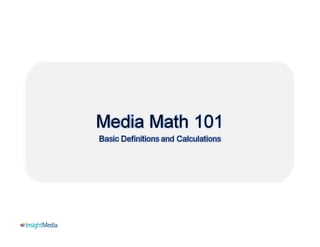
Media Math 101 Lexington
- 2. Total persons/homes in a given population, such as TV Households in the U.S. Universe = 10 HH
- 3. Acronym for Designated Market Area. DMAs are a way of designating particular geographic markets, and are often ranked by size of population. As it applies in Strata: DMA Includes all TV Homes: satellite, hard-wired cable, non-cable homes. Viewing reported to cable networks in the DMA could be in satellite or hard-wired homes. As it applies in Strata: CDMA Hard-wired cable universe (excludes satellite and non-cable homes).
- 4. The percent of total persons/universe tuned to a particular TV program during the average quarter hour.* Also called Average Audience. Rating: HHs Tuned to Program = 3 = .3 or 30% HH tuned to Universe 10 TV Program “XYZ” *Minimum of 5 minutes. 30 rating
- 5. Rating in a Cable Universe Cable HH Rating: HHs Tuned to Program= 3 = .6 or 60% Total Cable HHs (UE) 5 HH tuned to 60 rating TV Program “XYZ”
- 6. The estimated number of households with at least one television set turned on for five minutes or more during an average quarter-hour. TV is turned on HUT = 6
- 7. The percentage of TV sets in use tuned to a particular program. TV is turned on Share: HHs Tuned To Program = 3 = .5 or 50% HUT 6 HH tuned to 50 Share TV Program “XYZ”
- 8. Share in a Cable Universe Cable HH TV is turned on Share: HHs Tuning To Program = 3 = .75 or 75% Cable HUT 4 HH tuned to TV Program 75 Share “XYZ”
- 9. The audience expressed in numeric, rather than percent form. IMP = Rating(%) x Universe Also called Average Audience Projection. Also called Rating (000).
- 10. Gross Rating Points (GRPs) The sum of all ratings for all programs in a schedule. Gross Impressions (GIMPs) The GRPs expressed in numeric rather than percent form.
- 11. The number of different people/homes exposed at least once to a program or commercial across a stated period of time. Also called cumulative (cume) or unduplicated audience; can be expressed in full numbers or as a percentage. Total HHs: 10 Day 1 x x x Day 2 x Day 3 x Day 4 x x x Day 5 x x Day 6 x x Day 7 x x x 1 1 1 1 1 1 Number of Different HHs Reached: 6 Cume: Number of Different HHs reached = 6 = 60% Total TV Households 10
- 12. The average number of times a HH/person is exposed to a commercial. Total HHs tuned-in: 6 Exposure 1 x x x x x x Exposure 2 x x x x Exposure 3 x x x Exposure 4 x x x Exposure 5 x x 5 5 1 4 2 1 Total Number of Exposures: 18 Average Frequency: Number of Exposures = 18 = 3 times Total HHs Tuned In 6
- 13. The cost to deliver a single rating point. The cost of advertising per thousand potential customers reached by a given broadcast advertisement. CPM = (Media Cost/Impressions) x 1000
- 14. At the local level, Nielsen measures television audiences using three different methodologies depending on the market. In the smallest markets (currently markets ranked above #60) diaries (see right) are sent out four times a year during “sweep” months (Feb, May, July, November). The broadcasters tend to schedule premieres, specials and original programming during these “sweep” periods, and this “hyped” data is used for buying and selling the rest of the year. Diaries are used to collect both viewing (who) and tuning (how many people) to programs and networks. The diary is the least accurate collection method. In the next set of markets (ranked 14-60), set meters are used to capture set tuning continuously all year, while diaries are still mailed out during sweeps to capture demographics (who is watching). These two methods are joined together to develop audience estimates in these markets. In the top markets (ranked 1-13), local people meters (LPM) are used to electronically capture both tuning and viewing. The LPM is considered the standard of measurement in the US today. From The CAB for more information (such as “Buying in a Diary-Only Market,” “Buying in a Meter-Diary Market,” “Local People Meter Primer,” “Local Posting Guidelines”), visit www.thecab.tv
